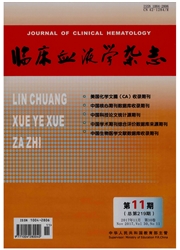

 中文摘要:
中文摘要:
目的:探讨适用于新生儿的输血前检验方法及输血策略。方法:收集20例诊断为ABO-HDN的患儿的血清及红细胞放散液,并随机取5份ABO同型红细胞制剂的血样同时用凝聚胺技术及微柱凝胶技术进行主侧交叉配血,评估2种配血方法结果之间的差异性,以及与直抗试验的相关性。结果:①在100次交叉配血中,微柱凝胶技术中血清及放散液出现不合为74次及62次,凝聚胺技术中血清及放散液出现不合为3次及5次,而联合所有血清及放散液出现不合79次;未出现1例配血为凝聚胺阳性而微柱凝胶阴性。②除了凝聚胺技术对患儿血清交叉配血外,直抗阳性的患儿血清及放散液交叉配血不合率均高于直抗阴性患儿(P〈0.05)。③2种方法在患儿血清(Kappa=0.021,P=0.297)及放散液(Kappa=0.063,P=0.072)交叉配血结果一致性无统计学意义,凝聚胺技术的灵敏度明显较低。结论:新生儿输血前检验增加直接抗球蛋白试验十分必要,微柱凝胶抗球蛋白技术更适宜新生儿交叉配血,最适的输血策略应为尽可能先进行溶血病的诊断来合理选择同型或相容性输血。
 英文摘要:
英文摘要:
Objective:To investigate the optimal protocol of pretransfusion tests and the transfusion policy for neonates.Method:20 samples of serum and elution from RBC of neonates with ABO-HDN were collected and crossmatched with 5 random RBC samples from RBC components simultaneously by manual polybrene test and micro column gel technique,then the difference between the two crossmatching methods and their relationship with direct antiglobulin test of ABO-HDN were assessed.Result:①Among 100 times of crossmatching tests,the incompatible numbers from serum and elution with micro column gel technique were 74 and 62,those numbers with manual polybrene test were 3 and 5.No one case with solely incompatible result from manual polybrene test accompanied by compatible from micro column gel technique was occurred.②Apart from incompatible crossmatching results in serum with manual polybrene test,the incompatible frequency of serum and elution in ABO-HDN neonates with positive direct antiglobulin test was high than those with negative direct antiglobulin test(P0.05).③There had no significant difference in the agreement of incompatible results from serum(Kappa=0.021,P=0.297) and elution(Kappa=0.063,P=0.072) by the two crossmatching methods,the sensitivity of manual polybrene test was obviously lower in crossmatching test.Conclusion:Direct antiglobulin test is essential for pretransfusion tests in neonates,and micro column gel technique is the more appropriate method for the crossmatching test in neonates.The best transfusion policy in neonates was the selection of blood components with the identical or compatible blood group by the diagnosis of hemolytic diseases of newborn in advance.
 同期刊论文项目
同期刊论文项目
 同项目期刊论文
同项目期刊论文
 期刊信息
期刊信息
